Answer: Just About Everywhere
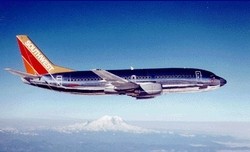 Somewhere in the world - at this very moment -
1,200 Boeing 737 jetliners are in the air flying people safely to
their destinations.
Somewhere in the world - at this very moment -
1,200 Boeing 737 jetliners are in the air flying people safely to
their destinations.
The Boeing 737 is the most popular commercial passenger jet of
all time. Each day, the 4,000 737s that are in service worldwide
carry a combined total of about 1.3 million passengers. Every 5.3
seconds, a 737 takes off from an airport somewhere on the
globe.
Since the first 737 took to the sky in 1968, the 737 fleet has
flown almost 49 billion nautical miles (56 billion miles) in about
124 million hours of service.
Almost Ubiquitous
 When
the earliest Boeing 737 model, the 737-100, was introduced in the
1960s, it brought jet travel to people in remote areas who had
never even seen a jet. Since then, 737s have opened new air travel
markets in areas such as northern Canada and the islands of the
South Pacific - in fact, in more new locations than any other
commercial airplane.
When
the earliest Boeing 737 model, the 737-100, was introduced in the
1960s, it brought jet travel to people in remote areas who had
never even seen a jet. Since then, 737s have opened new air travel
markets in areas such as northern Canada and the islands of the
South Pacific - in fact, in more new locations than any other
commercial airplane.
Today, operators fly 737s in 115 different countries as diverse
as the Caribbean's Trinidad and Africa's Tanzania - and the routes
and distances they travel vary widely. While many airlines use 737s
to transport passengers to sunny destinations, Seattle-based Alaska
Airlines operates 737s on a route of nearly 2,160 nautical miles
(4,000 km) from Chicago to Anchorage(AK).
The 737 is equally comfortable flying north-to-south or
east-to-west transcontinental routes, or short hops. Central
America's Copa Airlines holds the record for flying the 737's
longest commercial route - the 2,858 miles (4,600 km) from Panama
City at the top of the South American continent to Buenos Aires,
Argentina, in the south. A number of American airlines fly 737s
east and west across the North American continent several times
daily.
Conversely, Japan TransOcean Air holds the record for the
shortest 737 route - 7.6 nautical miles (14 km) between the
Japanese islands of Kita Daito and Minami Daito in the Pacific
Ocean. Aloha Airlines and Cayman Airways also use 737s on short
routes, island-hopping in the Hawaiian and Cayman Islands, and Air
Tanzania flies a 737 on the 35-nautical mile (65-km) journey from
Dar es Salaam to the Indian Ocean island of Zanzibar.
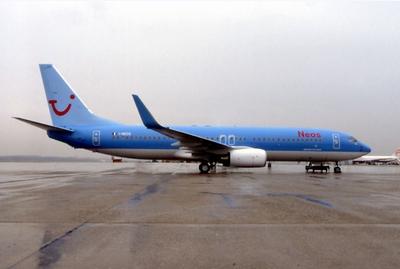
Flying Higher, Faster And Farther
The 737 has been upgraded continually with new technologically
advanced systems. Designed entirely on computer during the early
1990s, Boeing introduced its newest line of four 737 passenger
models called Next-Generation 737s. They are the 737-600, -700,
-800 and -900.
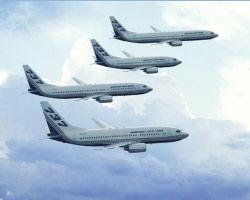 The 737-700 was the first of the four Boeing
designed and built. The first operator to order the model in 1993
was Southwest Airlines, a United States-based airline. The second
to see the advantages of this new airplane line was Maersk Air of
Denmark.
The 737-700 was the first of the four Boeing
designed and built. The first operator to order the model in 1993
was Southwest Airlines, a United States-based airline. The second
to see the advantages of this new airplane line was Maersk Air of
Denmark.
From nose to tail, the Next-Generation 737s are composed of the
latest technologies that make them all-new airplanes. They have
updated wings, engines, landing gear, auxiliary power units and the
newest flight-deck technologies.
The 737 wings are built at the Boeing factory in Renton, Wash.
They are produced in the same building where the Boeing 707 and 727
were once made. The 737 wings are built at the Boeing factory in
Renton (WA). They are produced in the same building where the
Boeing 707 and 727 were once made.
The four Next-Generation 737 models were designed to fly higher,
faster and farther than earlier 737s. At altitudes of 39,000 feet
(12,500 m), the airplanes fly higher than competing jetliner
models. Airlines benefit from that capability by being able to fly
above bad weather and the congested skies of densely populated
areas. Flying higher also provides passengers smoother rides.
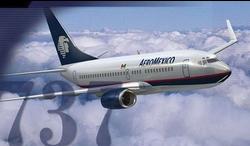
Flying faster and getting passengers to their destinations in
less time also is beneficial. The cruise speed of the newest 737s
is 478 nautical miles (885 km) per hour compared with the 430
nautical miles (796 km) per hour of older 737s.
The new wing, lower fuel consumption and other design features
of the newer 737s allow them to fly up to 896 nautical miles (1,660
km) farther than older 737s. This increases the number of
city-pairs on which airlines can use 737s, opening new markets for
carriers around the world.
Desktop Airplane Design
Although the overall design of the Next-Generation 737 models
was completed during the 1990s, engineering work continues today.
Engineering design of the Next-Generation 737 models is performed
at the Boeing manufacturing plant in Renton, a suburb of Seattle
located on the shores of Lake Washington.
To design jetliners, Boeing engineers use a computer software
program called CATIA that allows the use of two- and
three-dimensional graphics to create engineering drawings that show
every part and its relationship to other parts. Computers guarantee
the utmost precision, ensuring that each part fits exactly into the
next.
Every commercial operator chooses a slightly different
configuration - or layout - for its new 737s. Because of the large
range of options available, engineers must fine-tune the design of
each operator's airplanes, such as creating drawings for the
installation of a new type of in-flight entertainment system or a
special food-preparation galley.
Design also is ongoing, because Boeing continually makes
improvements to the flight-deck technology that pilots use to fly
the airplane and to other systems that improve airplane safety or
efficiency.
Assembling 367,000 Parts
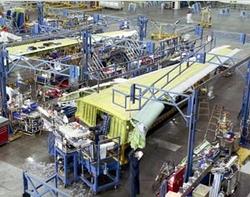 Boeing Commercial Airplanes performs major
assembly of all 737s at its factories in the United States;
however, parts for the airplanes come from suppliers all over the
world.
Boeing Commercial Airplanes performs major
assembly of all 737s at its factories in the United States;
however, parts for the airplanes come from suppliers all over the
world.
Assembling a 737 is a complex job. Factory employees must take
367,000 parts; an equal number of bolts, rivets and other
fasteners; and 36 miles (58 km) of electrical wire; and put them
all together to form an airplane.
The fuselage, or body of the airplane, is produced at a Boeing
plant in Wichita (KS). At that facility, employees attach the nose
section of the airplane's fuselage to the center and tail sections.
When the fuselage is complete, it is strapped aboard a railroad car
for a 2,175-mile (3,500-km) train ride across the United
States.
 When the train arrives at the Renton factory, the
fuselage is transferred to a large cart and wheeled to the final
assembly building, where it spends about 13 days. During the first
stage of final assembly, factory workers focus on the interior. In
the same way carpenters might finish the inside of a house, they
install insulation material along the inside walls of the fuselage,
then add wiring and plumbing.
When the train arrives at the Renton factory, the
fuselage is transferred to a large cart and wheeled to the final
assembly building, where it spends about 13 days. During the first
stage of final assembly, factory workers focus on the interior. In
the same way carpenters might finish the inside of a house, they
install insulation material along the inside walls of the fuselage,
then add wiring and plumbing.
When the fuselage is ready to move to the next stage of
production, an overhead crane located 89 feet (27 m) above the
floor lifts it high into the air and gently places it down into its
next position. Here, precision tools are used to install the
landing gear and the two wings, making the structure look like a
real airplane. At this point, the 737 can roll along the factory
floor and take its position in the moving production line.
Once the wings and landing gear are installed, the 737 is pulled
to the Moving Line. As each 737 moves along the assembly line, the
tail fin and horizontal stabilizer are added and all parts are
installed in the flight deck and passenger cabin. Once the wings
and landing gear are installed, the 737 is pulled to the Moving
Line. As each 737 moves along the assembly line, the tail fin and
horizontal stabilizer are added and all parts are installed in the
flight deck and passenger cabin.
A Henry Ford Line For Airplanes
Henry Ford introduced the moving assembly line to automobile
manufacturing a century ago. Boeing became the first commercial
airframe manufacturer to use the concept to build jetliners when
first the 717, and then the 737, production lines were transformed
into a moving line. The moving line helps reduce the time to
assemble the airplane and also cuts inventory and production
costs.
 The 737s on the line move continuously at a rate
of 2 inches (5 cm) per minute; the line stops only for employee
breaks, critical production issues or between shifts. Timelines
painted on the floor help workers gauge the progress of
manufacturing.
The 737s on the line move continuously at a rate
of 2 inches (5 cm) per minute; the line stops only for employee
breaks, critical production issues or between shifts. Timelines
painted on the floor help workers gauge the progress of
manufacturing.
Near the beginning of the moving line, an overhead crane lifts
the 23-foot high (7.1-m) tailfin into place so it can be attached.
Next, floor panels and serving galleys are installed and functional
testing begins.
A Tricky Little Test
In a test called the "high blow," mechanics pressurize the plane
to trick it into thinking it is flying 92,847 miles (28,300 m) in
the air (more than twice as high as it will fly in service). Then,
inspectors make sure there are no air leaks. In another test, large
yellow jacks lift the 154,983-pound (70,300-kg) airplane into the
air so employees can try out the landing gear retraction
system.
As the airplane moves closer to the end of the line, the rest of
the interior is completed - lavatories, luggage bins, ceiling
panels, carpets, seats and other essentials are installed. Right
before the 737 exits the final assembly factory, mechanics attach
the jet engines.
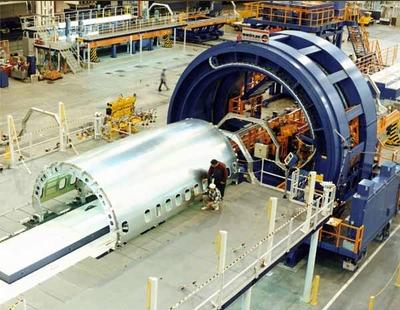
Once assembled, the airplane is towed to a hangar for painting.
About 50 gallons (189 l) of paint are used on an average 737; the
paint weighs approximately 300 pounds (136 km).
When painting is complete, the airplane is ready for a Boeing
test flight -one last step to make sure the 737 is ready to fly
passengers. After Boeing test pilots fly the airplane, the
customer's airline pilots take it for a test run.
When the customer test flight is complete, the 737 is ready for
delivery to its new owner. And one more plane is added to the
roster of 737s flying the skies worldwide.
 ANN's Daily Aero-Term (04.14.24): Maximum Authorized Altitude
ANN's Daily Aero-Term (04.14.24): Maximum Authorized Altitude ANN's Daily Aero-Linx (04.14.24)
ANN's Daily Aero-Linx (04.14.24) Classic Aero-TV: 'We're Surviving'-- Kyle Franklin Describes Airshow Life 2013
Classic Aero-TV: 'We're Surviving'-- Kyle Franklin Describes Airshow Life 2013 Aero-News: Quote of the Day (04.14.24)
Aero-News: Quote of the Day (04.14.24) Airborne 04.09.24: SnF24!, Piper-DeltaHawk!, Fisher Update, Junkers
Airborne 04.09.24: SnF24!, Piper-DeltaHawk!, Fisher Update, Junkers











